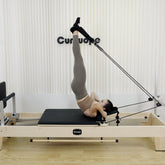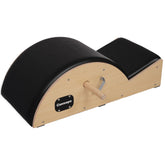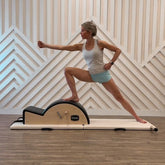Prenatal Pilates: Safe Exercises for Expecting Moms
Pregnancy is an exciting time filled with changes and challenges. Expecting mothers often find themselves navigating a range of physical and emotional experiences, and one of the most important aspects of this journey is maintaining physical health and well-being. Regular exercise is essential for a healthy pregnancy, but it's important to choose activities that are safe and beneficial for both the mother and the baby. Pilates, specifically designed for the prenatal stage, offers a low-impact, effective workout that helps to strengthen the body, improve flexibility, and alleviate some of the discomforts associated with pregnancy. In this blog, we will explore why Prenatal Pilates is an excellent choice for expecting moms and provide guidance on safe exercises during pregnancy.

What is Prenatal Pilates?
Pilates is a form of exercise that focuses on controlled movements, breath control, and building strength, flexibility, and endurance. Originally developed by Joseph Pilates in the early 20th century, Pilates has grown in popularity over the years and is now practiced by people of all ages and fitness levels. When it comes to prenatal Pilates, the goal is to provide a safe, gentle workout that targets areas of the body that are most affected by pregnancy, such as the core, pelvis, back, and hips. Prenatal Pilates can be adapted to meet the specific needs and capabilities of the expecting mother, whether she is in her first trimester or nearing her due date.
Benefits of Prenatal Pilates
Prenatal Pilates offers numerous benefits for both the expecting mother and the baby. It is an ideal form of exercise because it helps improve posture, enhances circulation, and relieves common pregnancy discomforts. Here are some key benefits of practicing Pilates during pregnancy:
1. Improved Core Strength
During pregnancy, the muscles of the core (abdomen, lower back, and pelvic floor) become stretched and weakened due to the growing belly and the increased weight placed on the body. Pilates focuses on strengthening these core muscles, which helps support the growing belly and reduce the strain on the lower back. A strong core can also make it easier to carry the added weight and can improve posture, which can often become imbalanced during pregnancy.
2. Relief from Back Pain
Back pain is one of the most common discomforts during pregnancy, especially as the baby grows and the center of gravity shifts. Prenatal Pilates exercises strengthen the muscles of the back and improve alignment, which can help alleviate the pressure on the spine and reduce pain. By building strength in the lower back and pelvis, Pilates can also help prevent the worsening of back pain as the pregnancy progresses.
3. Improved Flexibility
As the body changes and adjusts during pregnancy, flexibility tends to decrease. Prenatal Pilates includes stretches that target the hips, lower back, and pelvic area, helping to maintain or improve flexibility. Stretching exercises also help to prevent stiffness and discomfort, especially as the body prepares for childbirth.
4. Enhanced Posture
As pregnancy progresses, the body undergoes significant changes that can affect posture. The growing belly can cause the pelvis to tilt forward, leading to a condition called anterior pelvic tilt, which often results in lower back pain and discomfort. Prenatal Pilates exercises help strengthen the muscles of the back and abdomen, which can improve posture and reduce strain on the spine. Practicing good posture during pregnancy can also promote better breathing, which can be helpful during labor.
5. Increased Pelvic Floor Strength
The pelvic floor muscles play a crucial role during pregnancy and childbirth. These muscles support the uterus, bladder, and bowel, and their strength is essential for a smooth labor and delivery. Prenatal Pilates includes exercises that target the pelvic floor muscles, helping to strengthen them and prepare them for childbirth. Strengthening the pelvic floor also aids in post-delivery recovery and can help prevent issues like incontinence.
6. Reduced Swelling and Improved Circulation
Pregnancy can cause swelling in the feet, ankles, and hands due to increased fluid retention and changes in circulation. Pilates incorporates movement and stretching that promote better circulation throughout the body, which can help reduce swelling and improve overall vascular health. Additionally, the breathing techniques used in Pilates can enhance oxygen flow to the muscles and tissues, contributing to better circulation.
7. Stress Relief and Mental Well-Being
Pregnancy can be an emotional rollercoaster, and many expecting mothers experience anxiety, stress, and fatigue. Prenatal Pilates emphasizes deep breathing and mindfulness, which can help reduce stress and promote relaxation. Regular exercise, such as Pilates, releases endorphins, which are the body's natural mood boosters. This can help expecting mothers maintain emotional balance and a sense of calm.
Safe Pilates Exercises for Expecting Moms
When practicing Pilates during pregnancy, it is important to choose exercises that are safe for both the mother and the baby. Certain movements should be avoided, especially as the pregnancy progresses, to minimize the risk of injury. Always consult with a healthcare provider before beginning any new exercise routine during pregnancy. Below are some safe and effective Pilates exercises that can be included in a prenatal workout routine:
1. Pelvic Tilts
Pelvic tilts help to strengthen the lower back and pelvic floor while also promoting better posture. To perform a pelvic tilt:
- Lie on your back with your knees bent and feet flat on the floor, hip-width apart.
- Inhale deeply and as you exhale, gently press your lower back into the floor by tilting your pelvis.
- Hold for a few seconds and then return to the starting position.
- Repeat for 10–15 repetitions.
2. Cat-Cow Stretch
The cat-cow stretch is great for improving spinal mobility and alleviating back tension. To perform this stretch:
- Start on your hands and knees in a tabletop position.
- Inhale as you arch your back and look up, allowing your belly to drop toward the floor (cow position).
- Exhale as you round your back and tuck your chin to your chest (cat position).
- Repeat for 10–12 repetitions, moving slowly and mindfully.
3. Side-Lying Leg Lifts
Side-lying leg lifts help strengthen the hip muscles and improve stability. To perform this exercise:
- Lie on your side with your head supported by a pillow and your legs stacked on top of each other.
- Slowly raise the top leg toward the ceiling, keeping it straight and controlled.
- Lower the leg back down without letting it touch the bottom leg.
- Repeat for 10–12 repetitions on each side.
4. Squats
Squats are a great way to strengthen the legs and glutes while also improving pelvic floor strength. To perform a squat:
- Stand with your feet shoulder-width apart.
- Inhale as you lower your body into a squat position, keeping your knees behind your toes and your back straight.
- Exhale as you return to standing.
- Repeat for 10–15 repetitions.
5. Modified Plank
Planks are an excellent way to engage the core muscles, but they should be modified during pregnancy to ensure safety. To perform a modified plank:
- Start on your hands and knees, with your wrists directly under your shoulders and your knees under your hips.
- Engage your core and extend one leg straight behind you, keeping your body in a straight line.
- Hold the position for 10–20 seconds, then return to the starting position.
- Repeat on the other side.
6. Breathing and Relaxation Techniques
Breathing exercises are a core component of Pilates, and they are especially beneficial for prenatal women. Deep breathing helps relax the body, reduce stress, and improve oxygen flow to both the mother and baby. Practice slow, deep breaths, inhaling through the nose and exhaling through the mouth. Focus on expanding the diaphragm and relaxing the body with each breath.
When to Avoid Pilates During Pregnancy
While Pilates is generally safe for most pregnant women, there are certain times when it should be avoided or modified. These include:
- If you have been advised by your doctor to avoid exercise due to complications such as high blood pressure, preterm labor, or certain pregnancy-related conditions.
- If you experience any discomfort, pain, or dizziness during a workout.
- If you are in the third trimester and exercises involving lying on your back or excessive bending should be avoided, as these positions can restrict blood flow to the baby.
Conclusion
Prenatal Pilates offers a safe, effective, and low-impact way for expecting mothers to stay fit and healthy throughout their pregnancy. By focusing on core strength, flexibility, posture, and pelvic floor strength, Pilates helps prepare the body for labor and delivery while alleviating common pregnancy discomforts. As with any exercise program during pregnancy, it’s important to listen to your body and consult with your healthcare provider before beginning a new routine. With the right precautions and modifications, Pilates can be a valuable tool in ensuring a healthy and happy pregnancy.





